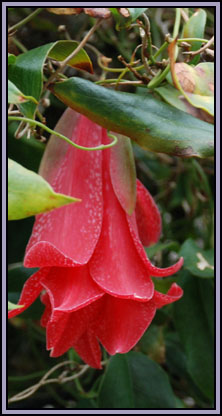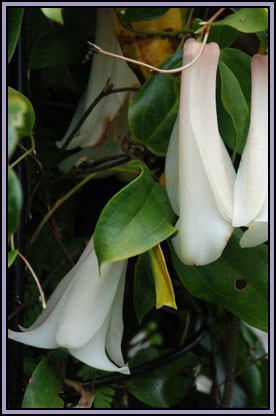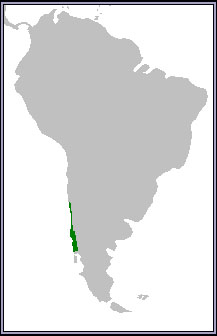|
|
|
|
| In 2001 I had a telephone call from
an Australian nursery man who lived in the
Melbourne Mountains requesting to buy auricula
from me - not really buy, he asked was I
prepared to exchange plants,
he wanted auricula and he would send me plants
of Lapageria.
|
|
Never ever grown
Lapageria as I thought they needed warm
conditions of a conservatory; he assured me I
could grow them as I had listed in my
catalogue Philesia magellanica, asked if I
grew Philesia outside, to which I replied in
the affirmative, he said in that case you can
grow Lapageria outside. Cultural suggestions,
he said the plants had to face east, outside,
and do not let them dry out during the summer,
and when they flower, ‘They will knock your
socks off’
|
|
 |
.jpg) |
|
|
L. Double Red |
L.
Rosado Fuente |
|
|
|
 |
 |
As
promised he sent me some very good strong plants,
about 12 different varieties, including 300 seeds of
Lapageria rosea album, giving me instructions on how
to get them germinate.
I think every seed germinated and they grew
very quickly into good strong plants. The
instructions I was given by my Australian friend on
how to germinate the seeds, was to germinate them in
heat and humid conditions, and as I have a
propagator temperature about 75F – 23C I placed
the seeds in the propagator. The
growing medium was 100% vermiculite.
|
|
There
were signs of germination in as little time as 6
weeks. The seed sowing was in
2001 therefore I cannot be too precise regarding
times. |
|
L.
Pan de Piedra |
L.
Nuba Blanca |
|
|
I
kept them in the heat until the seedlings were well
formed. Timescale,
not sure how long they were under heat, maybe three
months. After being an environment of heat and
humidity the seedlings had to be hardened off, I
placed them in a cool part of the glasshouse to
harden them off before potting up the young climbers
into 9cm pots. Within
a year the plants were saleable.
The named varieties grew well, and put on a lot of
growth, and soon I had to plant them into 40 litre
pots.
Sadly
I did lose nine of them when a few years ago the
temperatures plummeted to about minus 11 for about a
week, and very windy.
|
| I
also lost 12 Tree Ferns that year as well. Tree
Ferns are much easier to replace. Happy to say the three Lapageria
survived - two of the plants I had to give a lot
of tender loving care, but this year (2016) they
repaid my kindness and flowered very well. I start
looking at the vines during July to see if the
flowering buds are beginning form on the plant,
gradually the buds increase in size, I would say it
takes 6 weeks before the first trumpets show
themselves, once flowering
the vines give a wonderful display until New
Year.
|
|
|
|
Lapageria is of course no 'Alpine', coming from the
Valdivian temperate rainforest in Chile, but a nice
plant nevertheless. A member of the order Liliales
(which also contains the family Liliacea) |
 |
|
The common name for the Lapageria is ‘Chilean
Bellflower’, the large waxy trumpets are indeed
quite remarkable, size of trumpet 7.5 cm, it is an
evergreen vine and climbs counter clockwise.
I have to say the leaves can get a bit
scruffy and do need to be tidied (if you are that
fussy). Snails
nibble the leaves a bit. The leaves are very
leathery, my impression is that they are too tough
for the snails as they do very little damage to the
leaves. |
| The plants are
hermaphrodite (both sexes are on one plant) the
plant must have acid conditions, no lime.
Even so I have never had any seeds on my
Lapageria rosea album, the seeds capsules are on the
plant for a year before the seed is ripe enough to
sow, I keep looking and living in hope seed will be
produced one day.
|
|
|
|
The large waxy trumpets
hardly look real, as if they have been made out of
icing sugar and very beautiful, and really do ‘Knock
my socks off’
|
|
|
|
|
|
|
|
|
|
|
